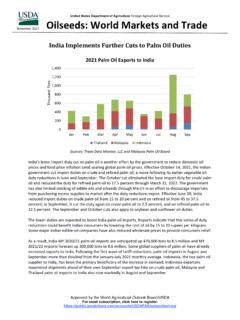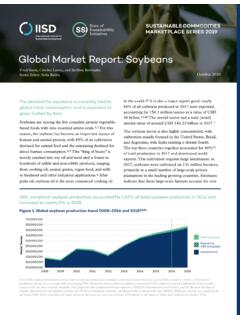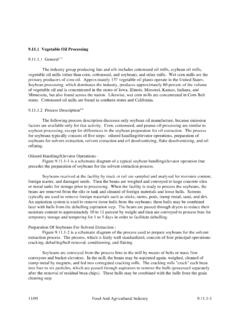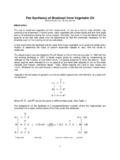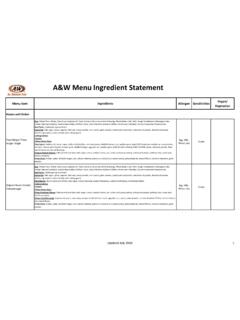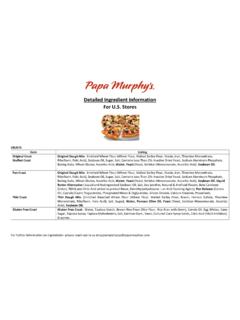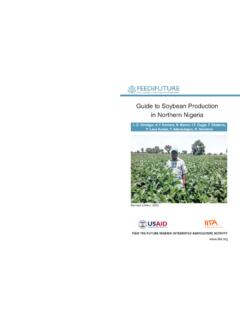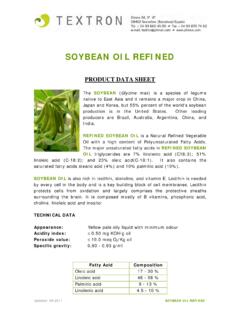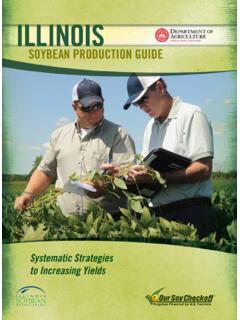Transcription of Vegetable Oil Production: Industry Profile
1 Vegetable Oil Production: Industry Profile Preliminary Final Report Prepared for Linda Chappell Environmental Protection Agency Air Quality Standards and Strategies Division Office of Air Quality Planning and Standards Innovative Strategies and Economics Group MD-15. Research Triangle Park, NC 27711. Prepared by Research Triangle Institute Center for Economics Research Research Triangle Park, NC 27709. EPA Contract Number 68-D4-0099. RTI Project Number 7018-54. February 1998. EPA Contract Number RTI Project Number 68-D4-0099 7018-54. Vegetable Oil Production: Industry Profile Preliminary Final Report February 1998. Prepared for Linda Chappell Environmental Protection Agency Air Quality Standards and Strategies Division Office of Air Quality Planning and Standards Innovative Strategies and Economics Group MD-15. Research Triangle Park, NC 27711.
2 Prepared by Mary K. Muth Brooks M. Depro Jean L. Domanico Research Triangle Institute Center for Economics Research Research Triangle Park, NC 27709. CONTENTS. Section Page 1 INTRODUCTION .. 1-1. 2 THE SUPPLY SIDE .. 2-1. Production Process, Inputs, and Outputs . 2-1. Production Process .. 2-1. Inputs .. 2-12. Types of Products and Services .. 2-14. soybean Oil .. 2-14. Corn Oil .. 2-15. Cottonseed Oil .. 2-15. Major By-products, Co-products, and Substitution Possibilities .. 2-15. Cake and Meal .. 2-16. Hulls .. 2-16. Linters .. 2-16. Lecithin .. 2-16. Soapstock .. 2-17. Deodorizing Distillates .. 2-17. Spent Bleaching Earth .. 2-17. Costs of Production .. 2-19. 3 THE DEMAND SIDE .. 3-1. Product Characteristics .. 3-1. Functional Characteristics .. 3-2. Perceptions About Health Effects . 3-3. Uses and Consumers .. 3-6.
3 Edible Uses of Vegetable Oils .. 3-7. Inedible Uses of Vegetable Oils . 3-10. Percentages of Vegetable Oils Used in Various Products .. 3-13. Elasticity of Demand .. 3-16. iii iv CONTENTS (CONTINUED). Section Page Substitution Possibilities in Consumption .. 3-16. Tropical Oils .. 3-17. Animal Fats .. 3-17. Olive Oil .. 3-18. Olestra .. 3-18. 4 Industry ORGANIZATION .. 4-1. Market Structure .. 4-1. Facility Characteristics .. 4-4. Wet Corn Milling .. 4-15. Cottonseed Oil Mills .. 4-15. soybean Oil Mills .. 4-18. Vegetable Oil Mills, Except Corn, Cottonseed, and soybean .. 4-18. Current Trends .. 4-20. Company Characteristics .. 4-21. Ownership .. 4-22. Size Distribution .. 4-22. Horizontal and Vertical Integration .. 4-26. Small Businesses Impacts .. 4-28. 5 MARKETS .. 5-1. Historical Market Data .. 5-1. Domestic Production.
4 5-1. Domestic Consumption .. 5-4. Vegetable Oil Prices .. 5-6. Imports and Exports .. 5-10. Trends and Projections .. 5-17. Future Prices .. 5-17. Trends in Consumption .. 5-17. Trends in Production .. 5-19. REFERENCES .. R-1. v vi FIGURES. Number Page 2-1 Conventional soybean preparation .. 2-2. 2-2 Flow diagram of the conventional solvent extraction process .. 2-5. 2-3 soybean -crushing plant operating expenses vs. plant size .. 2-25. 3-1 Per-capita consumption of oils and fats in the : 1995 .. 3-9. 3-2 consumption of soybean , corn and cottonseed oil by use: 1996 .. 3-14. 4-1 Distribution of wet corn milling facilities by sales range .. 4-16. 4-2 Distribution of wet corn milling facilities by employment range .. 4-16. 4-3 Distribution of cottonseed oil facilities by sales range .. 4-17. 4-4 Distribution of cottonseed oil facilities by employment range.
5 4-17. 4-5 Distribution of soybean oil facilities by sales range .. 4-19. 4-6 Distribution of soybean oil facilities by employment range .. 4-19. 4-7 Distribution of Vegetable oil mills, except corn, cottonseed, and soybean facilities by sales range .. 4-20. 4-8 Distribution of Vegetable oil, except corn, cottonseed, and soybean facilities by employment range .. 4-21. 4-9 Distribution of companies that own Vegetable oil manufacturing facilities by sales range .. 4-26. 4-10 Distribution of companies that own Vegetable oil manufacturing facilities by employment range .. 4-27. 5-1 Production of corn, cottonseed, soybean , and all other Vegetable oils: 1984-1996 .. 5-3. vii viii TABLES. Number Page 2-1 Value and Percentages of Products and By-products for Soybeans, Corn, Cottonseed, and Peanuts: 1992 . 2-18. 2-2 Labor, Material, and New Capital Expenditure Costs by SIC for Vegetable Oils: 1977, 1982, 1987, 1992-1995.
6 2-20. 2-3 Average Hourly Earnings, Value Added Per Production Worker Hour and Labor and Material Costs Relative to Value of Shipments by SIC. for Vegetable Oils: 1977, 1982, 1987, 1992-1995 .. 2-22. 3-1 Per-Capita Consumption of Oils and Fats in the : 1975-1995 .. 3-4. 3-2 Quantities of Oils and Fats Used in Edible Products in the : 1987-1994 .. 3-8. 3-3 Vegetable Oils by Edible and Inedible Uses: 1996 . 3-15. 3-4 Estimated Own Price Elasticities for Vegetable Oils and Substitutes .. 3-17. 4-1 Measures of Market Concentration by SIC: 1992 .. 4-3. 4-2 Facility-level Sales and Employment for Solvent Extraction Vegetable Oil Manufacturing Facilities . 4-6. 4-3 Number of Solvent Extraction Vegetable Oil Facilities by State and SIC Code .. 4-13. 4-4 Company-level Data for Solvent Extraction Vegetable Oil Manufacturers .. 4-23.
7 4-5 Characteristics of Small Businesses in the Solvent Extraction Vegetable Oil Industry .. 4-29. 5-1 Production of Edible Vegetable Oils: 1984-1996 .. 5-2. 5-2 5-year Average Annual Growth Rates in Production of Vegetable Oils: 1992-1996 .. 5-4. 5-3 Consumption of Edible Vegetable Oils: 1984-1996 .. 5-5. 5-4 5-Year Average Annual Growth Rates in Consumption of Vegetable Oils: 1992-1996 .. 5-7. ix x TABLES (CONTINUED). Number Page 5-5 Average Current Dollar Prices of Crude Vegetable Oils: 1970-1996 .. 5-8. 5-6 Prices for Other Fats and Oils: 1995-1996 .. 5-9. 5-7 Imports and Exports of Edible Vegetable Oils: 1984-1996 .. 5-11. 5-8 Current Dollar Value at Crude and Refined Vegetable Oil Imports and Exports, 1995-1996 .. 5-15. 5-9 Value of Selected Crude and Refined Vegetable Oil Imports and Exports by Country: 1996 .. 5-16.
8 Xi SECTION 1. INTRODUCTION. The Environmental Protection Agency's (EPA's) Office of Air Quality Planning and Standards (OAQPS) is compiling information on Vegetable oil plants as part of its responsibility to develop National Emission Standards for Hazardous Air Pollutants (NESHAP) under Section 112 of the 1990 Clean Air Act. The NESHAP is scheduled to be proposed in 1999 and the Innovative Strategies and Economics Group is responsible for developing an economic impact analysis (EIA). in support of the evaluation of impacts associated with the regulatory options considered for this NESHAP. This Industry Profile of the Vegetable oil Industry provides information to be used to support the EIA of the NESHAP. The Vegetable oil Industry includes the following SIC. codes: SIC 2046 Wet Corn Milling, SIC 2075 soybean Oil Mills, SIC 2074 Cottonseed Oil Mills, and SIC 2076 Vegetable Oil Mills, not elsewhere classified ( ).
9 Of the facilities classified as wet corn mills (2046), only nine produce corn The facilities included in SIC 2076 process peanut, sunflower, canola (rapeseed), safflower, and other minor oilseeds. 1-1. soybean oil processors comprise the largest share of the Vegetable oil Industry , producing about 75 percent of the domestic supply of Vegetable oil. Vegetable oils are used almost entirely for human consumption, although small quantities are used for industrial purposes such as in paints, resins, and animal feeds. According to the 1992 Census of Manufactures, the most recent year for which complete data are available, 221 establishments make up the industries in these four SIC. ,3 In 1995, these industries employed 19,500 people and had a total value of Industry shipments of $953 About half of these establishments use a solvent extract process to produce Vegetable oils.
10 The others use a mechanical extraction process. However, data reported by the Bureau of the Census group both types of establishments together. The establishments that use solvent extraction processes produce hexane emissions one of two sources of air pollution for this Industry . The other source, particulate emissions, is not the subject of the NESHAP. To produce crude Vegetable oil, processors prepare the oilseeds for extraction and then extract the oil using the solvent hexane, which EPA lists as a hazardous air This Industry Profile report is organized as follows. Section 2 includes a detailed description of the production process for Vegetable oils, with discussions of individual oil 1-2. products, oilseed inputs, and costs of production. Section 3. describes the characteristics, uses, and consumers of Vegetable oils as well as substitution possibilities.










